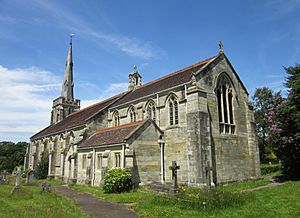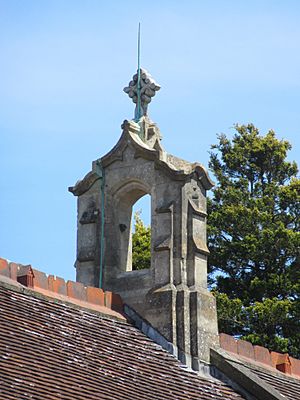St Mark's Church, Hadlow Down facts for kids
Quick facts for kids St Mark's Church |
|
|---|---|
| Church of St Mark the Evangelist | |

The church from the southeast
|
|
| 50°59′48″N 0°10′43″E / 50.9967°N 0.1787°E | |
| Location | Main Road, Hadlow Down, East Sussex TN22 4HY |
| Country | England |
| Denomination | Church of England |
| Churchmanship | Modern Catholic |
| History | |
| Status | Parish church |
| Founded | 1834 |
| Founder(s) | Benjamin Hall |
| Dedication | Mark the Evangelist |
| Consecrated | 6 May 1836 |
| Architecture | |
| Functional status | Active |
| Heritage designation | Grade II |
| Designated | 31 December 1982 |
| Architect(s) | William Moseley (1834 building); George Fellowes Prynne (1913 rebuilding) |
| Style | Perpendicular Gothic Revival |
| Completed | 1836 |
| Administration | |
| Parish | Buxted and Hadlow Down |
| Deanery | Rural Deanery of Uckfield |
| Archdeaconry | Lewes and Hastings |
| Diocese | Chichester |
| Province | Canterbury |
St Mark's Church, also known as St Mark the Evangelist, is a special church in the village of Hadlow Down, East Sussex, England. It belongs to the Church of England. The church was started in 1834 by a local person who wanted to help the villagers.
Even though there were other churches nearby, St Mark's became very popular. It was made bigger in 1913. This stone church has a tall spire and a churchyard that is also a nature reserve. Today, it is the only place of worship left in Hadlow Down. It is a Grade II Listed building, which means it is an important historical and architectural site.
Contents
History of St Mark's Church
Hadlow Down's name comes from Anglo-Saxon times. It was first called Headda's leah, meaning a forest clearing belonging to someone named Headda. The word "Down" was added later, in the 1300s, because the area has hills. The village as we know it today started to grow in the early 1800s.
Why a New Church Was Needed
Hadlow Down was located between two large villages, Buxted and Mayfield. People living in Hadlow Down had to travel more than three miles to reach their churches. Benjamin Hall, who lived in a big house called Buxted Lodge, was worried about this. He saw that many villagers, especially children, were not able to go to church.
Also, a different kind of church, called a Nonconformist chapel, had opened in Hadlow Down in 1824. This chapel, called Providence Chapel, was attracting people away from the Church of England.
In 1834, Benjamin Hall wrote to the Archbishop of Canterbury, William Howley. He asked for permission and money to build a new church in Hadlow Down. He explained that many poor children were "wandering about the lanes in ignorance." The Archbishop liked Hall's idea. Soon after, a group called the Society for Building Churches and Chapels was formed to help fund new churches.
Building the First Church
Most people in Hadlow Down were poor farm workers in the early 1800s. Despite this, Benjamin Hall worked hard to raise money for the church. He wrote a document explaining why the church was needed. He said that about 700 people lived in the village, and their churches were too far away.
The cost to build the church was estimated at £1,800. He also needed money to pay the vicar, about £100 a year. Hall listed people and banks where donations could be sent. Important people like the Archbishop of Canterbury and the Earl of Liverpool gave money. Even local farmworkers gave small amounts, like five shillings. This encouraged others to donate. The church also received £200 from a fund called "Queen Anne's Bounty" and £200 worth of stone from the 5th Earl De La Warr.
A local company built the church based on designs by William Moseley. Moseley designed other churches in Sussex. His plan for St Mark's included a main hall (nave), a special area for the altar (chancel), and a tower with a slim spire at the west end. The church could hold about 420 people.
Building work began on April 21, 1835, and finished in 1836. The Archbishop of Canterbury, William Howley, officially opened the church on May 6, 1836, with 500 guests. In 1837, St Mark's became a parish church, serving its own local area.
Changes and Rebuilding
By 1913, the church needed repairs. The spire was too heavy for the tower, causing damage. It had to be made shorter, but this did not fix the problem. Charles Lang Huggins, a relative of Benjamin Hall, paid for the church to be rebuilt. He used stone from his own land.
The new design was by architect George Fellowes Prynne. He had studied architecture in Canada and designed many church features in Sussex. It's not fully clear how much of the church he rebuilt. The chancel and the side aisles were completely new. The main hall (nave) kept its original stone, but the windows and arches were likely changed by Fellowes Prynne. The tower and spire were also repaired, but they looked similar to before. A small bell tower (bellcote) was added to the roof. Electric lights were also installed.
One of the workers who built the spire played a trick by putting the weather vane upside down. He was fired for this joke! The Bishop of Chichester officially opened the rebuilt church in October 1913.
The Churchyard as a Nature Reserve
In 1931, people were concerned about the churchyard looking "overgrown." They wanted to make it tidier. However, this plan did not fully succeed. Over many years, a wide variety of wild flowers grew in the churchyard. Today, it is cared for as a nature reserve by the "Living Churchyard" project.
A famous person buried here is Brigadier-General Edmund Costello. He received the Victoria Cross medal in 1897 for his bravery.
Architecture of St Mark's Church
St Mark's Church is built in the Gothic Revival style, which was popular in the 1800s and early 1900s. It looks like churches from the 1300s. The church is made entirely of local stone.
Key Features
- Tower and Spire: At the west end, there is a short tower with a pointed roof called a broach spire. The spire has wooden shingles and small windows. The bottom of the tower forms a porch, which is the entrance to the church.
- Nave and Aisles: Inside, the main hall (nave) has a special roof with arched beams. It has aisles (side passages) on both sides. This layout was a favorite of George Fellowes Prynne.
- Chapels and Vestry: The side arches lead to a Lady chapel (a small chapel dedicated to Mary) and a vestry (a room where clergy prepare).
- Bellcote: On the roof of the chancel (the area near the altar), there is a small bell tower called a bellcote.
Inside the Church
The church has many interesting features:
- Rood Screen: There is a beautiful wrought iron screen that separates the nave from the chancel. It is thought to be designed by Fellowes Prynne.
- Stained Glass: The large east window has stained glass from the early 1900s. There are also smaller stained glass windows in the Lady chapel from 1949–50.
- Paintings: A painting called Madonna of the Magnificat is in the church. It was painted by Edward Arthur Fellowes Prynne, the architect's brother. He designed many paintings and stained glass windows for churches. This painting was bought by Charles Lang Huggins, who then gave it to St Mark's Church.
- Other Windows: Two windows by Percy Bacon show "Madonna & child with angels" and "Suffer little children." A smaller window by Francis Skeat from 1948 shows the Christian year using wild flowers.
St Mark's Church Today
St Mark's Church was officially recognized as a Grade II Listed building on December 31, 1982. This means it is a "nationally important" building. In February 2001, it was one of over 2,000 Grade II listed buildings in the Wealden area.
The church is now part of a larger parish with Buxted. This area is called the Parish of Buxted and Hadlow Down. It includes three churches and covers a large countryside area. About 5,000 people live in this parish.
St Mark's Church also has a connection with St Mark's Church of England Primary School. The school was built next to the church in the late 1800s. It serves a large area, mostly rural.
See also


